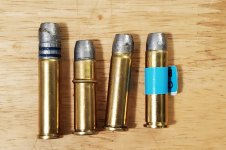Well, I have been reloading for about 14 years. I was hanging out with my friend who taught me to shoot and reload and has been reloading longer than I have been alive.
We were both a little tired, we ran into a couple issues, and made a couple mistakes which I hope you will find interesting or at least entertaining. This is 357mag with 180g gas checked lead bullets.
from left to right
#1 my friend is used to seating and crimping in the same operation. However we were using my lee factory crimp die. the bullet was press fitted into the case ready to be seated, but we forgot to take out the crimp die and put the seater back in first, thus we have a round crimped just above the gas check.
#2 later on we decided to crimp and seat in 1 step due to issues. We set our dies for seat and crimp using hornady brass, and it was a touch shorter than the other brass we were switching over to, which we found out the hard way. Thus the crimp on the longer case, quite impressively, buckled the case.
#3 Not sure exactly how we did it, but we adjusted the lee factory crimp die down too far, resulting in a pretty crazy crimp.
#4, We ended up with a squib. We hade loaded 4 for testing, and realized we still had 1 powder charge in the pan on the scale. We were throwing around 15g of powder so we just weighed them out. put a sticker on it so it would not get lost.

Happy and safe reloading.
We were both a little tired, we ran into a couple issues, and made a couple mistakes which I hope you will find interesting or at least entertaining. This is 357mag with 180g gas checked lead bullets.
from left to right
#1 my friend is used to seating and crimping in the same operation. However we were using my lee factory crimp die. the bullet was press fitted into the case ready to be seated, but we forgot to take out the crimp die and put the seater back in first, thus we have a round crimped just above the gas check.
#2 later on we decided to crimp and seat in 1 step due to issues. We set our dies for seat and crimp using hornady brass, and it was a touch shorter than the other brass we were switching over to, which we found out the hard way. Thus the crimp on the longer case, quite impressively, buckled the case.
#3 Not sure exactly how we did it, but we adjusted the lee factory crimp die down too far, resulting in a pretty crazy crimp.
#4, We ended up with a squib. We hade loaded 4 for testing, and realized we still had 1 powder charge in the pan on the scale. We were throwing around 15g of powder so we just weighed them out. put a sticker on it so it would not get lost.
Happy and safe reloading.
Attachments
Last edited:

